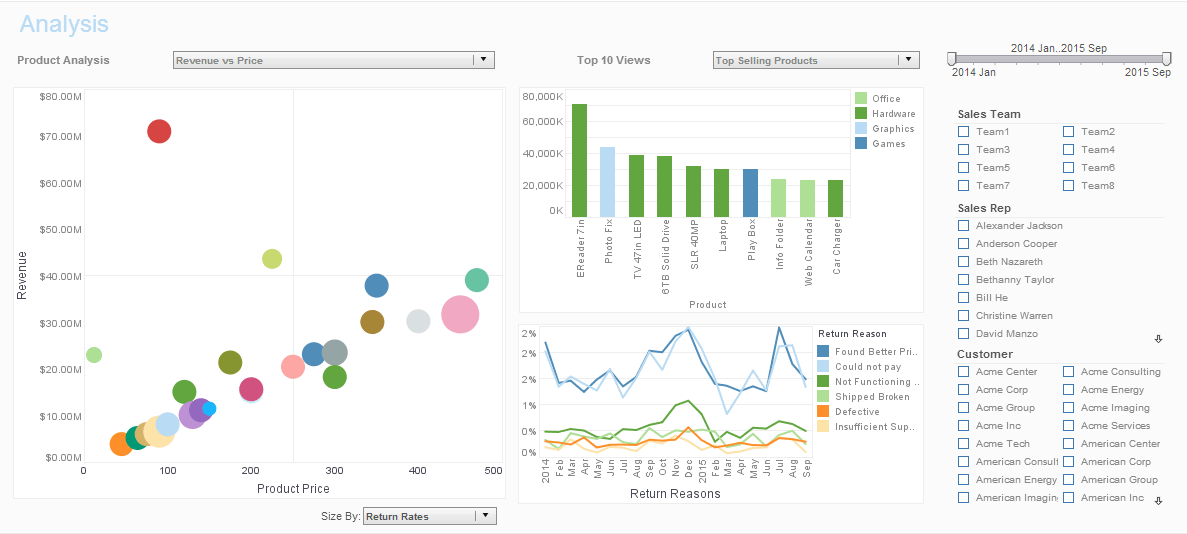Key Requirements for Mobile BI
This is a continuation of the transcipt of a webinar hosted by InetSoft. The speaker is Mark Flaherty, CMO at InetSoft, and he discusses the topic “The Advantages of Mobile Business Intelligence."
Mark Flaherty: I would like to highlight a couple of our findings based on the work we have done with our customers. The first point I want to make is around the tablet as a perfect form factor for mobile business intelligence. As I mentioned earlier, InetSoft supports a variety of mobile devices including iPhone and BlackBerries.
And we have had numerous clients interested in rolling this capability out to their business users. However, I believe that with the emergence of the Apple iPad and other hot new tablets like the PlayBook or the Xoom that are hot on Apple’s heels, the reality of mobile BI is truly possible. In fact tablets really are the perfect form factor for mobile BI for a number of key reasons.
The first and perhaps most obvious is that tablets are very portable. Perhaps you can’t fit them in your pocket like you can with the smartphone, but is much easier to carry your tablet with you than your laptop. Whether you are going to the showroom floor or into the factory, to an impromptu meeting in the cafeteria or just down the hall, bringing your tablet, the tablet is the ideal device.
| #1 Ranking: Read how InetSoft was rated #1 for user adoption in G2's user survey-based index | Read More |
The second reason is that the iPad and other tablets provide larger, much more visually appealing displays, perfect for visualizing key performance indicators and digging into detailed metrics. I really believe that the smartphone screen size has been an inhibitor to using it for much more than receiving alerts or viewing very simple information; a single indicator. I don’t think it's really practical to fully analyze information and discover new insights and answer new questions in a lot of depth.
Now you can access corporate information from just about anywhere with the combination of increasingly reliable and available wireless networks and more and more Wi-Fi availability. Blackout areas are fewer and farther in between. This allows users to get up-to-date information rather than relying on hours or days-old static reports or canned dashboards. Their decisions can be made with the latest information enabling better decision making. Thus, the idea of delivering business intelligence to mobile devices isn’t really that new. The rise of the tablet, thanks in large part of the Apple iPad, is truly making mobile BI a reality.
If you have a mobile workforce or business users who need access to information that make business decisions away from their desks you should be looking at how tablet based mobile BI solutions can meet that need. And if you do have or will have tablet users, as a number of you have indicated, what requirements should you consider in a tablet based BI solution? That’s a second area I want to touch on here.
Based on our experience with earlier customers I want to lay out five key requirements for mobile BI based on an overall theme that mobile BI users expect freedom. I won’t go into core business intelligence requirements here. Instead I want to focus specifically on mobile BI capabilities that must exist for any BI solution to be successful, in meeting mobile BI user requirements. I will describe what I mean by freedom in terms of BI over the next few points. But think about the mobile user, they have a tablet or smartphone and use it wherever they are, in a meeting, at the airport, on the shop floor, in the factory. They want the freedom to use the device wherever they are and applications on those devices should also answer that call for freedom.
 |
View live interactive examples in InetSoft's dashboard and visualization gallery. |
A key example of that freedom is the ability to answer any question. Users don’t want their tablet to simply be a pretty piece of paper. They don’t want to replicate that green bar report on a tablet and just be able to look at it whenever they want. They don’t want just a pre-defined set of questions. They want to be able to ask new questions. If the key performance indicator says that sales are down in a particular region, they want to ask what products are selling there and how does that compare with other regions. If inventory is low for a particular product they want to check inventory for similar products elsewhere. They want the freedom to ask questions that they have when they have them and get the answers right then and there.
In order to ask those questions though, they need to access any given information. These solutions need to provide access to information from corporate data warehouses, information from CRM systems, from spreadsheets, from Web data. Whatever data is relevant to answering that question should be available on their tablet when they need it. Don’t constrain the user, give them the freedom to access the information they need to answer their questions.
| Previous: Technology, Employees, and Organizations |


